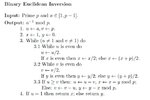Poomagal
Newbie level 6
To find modular inverse value, I found the availability of Binary/Extended Euclidean algorithm.I have written the synthesizable code for this algorithm. But while i execute the testbench, I cannot get the output and also its got hanged-on and i need to power off the system without proper shutdown. Please help me to find and solve this error. FYI, I have attached the verilog code which I have written to analyse it.
verilog code:
verilog code:
Code Verilog - [expand]
Last edited by a moderator:
